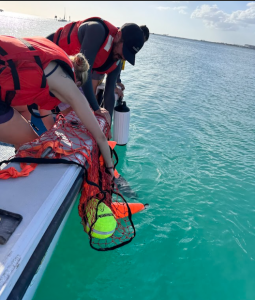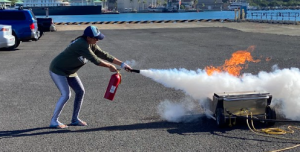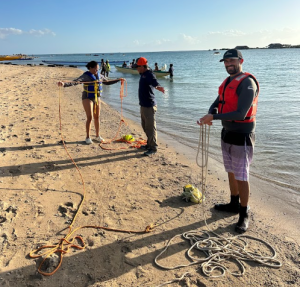3/4/25 – Motorboat Operator Certification Course

Staff practice victim recovery with the Motorboat Operator Certification Course.
This January, members of the Division of Aquatic Resources (DAR) had the opportunity to participate in the Motorboat Operator Certification Course (MOCC). MOCC is a basic seamanship course designed to teach individuals the necessary skills and knowledge to safely operate a motorized boat or vessel. The course covers a wide range of topics related to boating safety, regulations, operations, navigation, emergency procedures, environmental awareness, equipment, and maintenance.
DAR identified the need for standardized training for boating operations. Staff members who had attended previous MOCC courses hosted by the National Oceanic and Atmospheric Administration (NOAA) and the US Fish and Wildlife Service (USFWS) found them to be highly beneficial. Standardizing boating operations across all of DAR’s teams has the added benefit of streamlining collaborative projects and allowing for the easy sharing of resources. To that end, DAR members from across the state were invited to attend this session MOCC. DAR staff were trained by instructors from the NOAA, USFWS, and Hawaiʻi Ocean Safety
Three Day Course
MOCC was a 3-day course with both classroom and field exercises. Day one was a combination of classroom exercises and field exercises to practice basic emergency procedures such as PFD fit checks, swim tests, rescue techniques, proper use of fire extinguishers, HELP/HUDDLE/Linked swim, and using throw ropes and rings. Days two and three were conducted on the water and focused on teaching safe boating practices. This was done through a rotating series of live drills, each teaching a different boating skill. The four stations were docking practice, close-quarter maneuvering, obstacle avoidance and victim recovery, and trailering and knot tying.

A DAR staff member practices extinguishing an onboard fire.
Docking and Tying
The first station taught DAR staff how to dock and tie up a boat safely. Learning different angles of approach allows boaters to correct for various wind directions or to adjust based on the space available at a dock and ocean conditions. DAR staff took turns practicing approaching from each of the available angles and learning to undock using either a push-off method with assistance from additional crew or the bump method to maneuver away from the dock while in tight corridors. Continuing work in tight spaces, the second station involved mastering a star drill. Because undocking and dropping divers into the water often involves moving close to reefs or other hard structures, it is important to be able to control a boat in tight spaces with little leeway. The star drill taught DAR staff to execute a 360-degree turn within a small area and nose up or back up to objects without bumping the bow or the prop of the boat.
Avoiding Obstacles
Moving out of the confined areas, the next station was to practice avoiding obstacles and victim recovery in the open water. In an ideal situation, objects in open areas will be spotted by crew members well in advance and can be easily avoided. However, sometimes, objects or animals can suddenly appear in front of a boat under power, necessitating quick reactions by the captain. Victim recovery drills involved a team of individuals and necessitated clear and concise communication between crew members. While one person practiced safely maneuvering the boat alongside a victim in the water, one or two other crew members practiced using boat hooks, recovery nets, and various pull techniques to recover the “victim” (in this case, a floating dummy) into the boat. Beyond the skills practiced in these drills, this allowed DAR staff to work on communication skills. While it is never pleasant to think about a situation where a rescue will need to be performed, practicing these situations in a safe environment ensures that staff have the tools and knowledge at their disposal in case a time should arise when these skills will be necessary.

DAR staff brush up on basic knot tying.
Trailering and Knot Tying
The final station involved trailer practice and knot tying. Fine-tuned trailering skills are just as important as fine-tuned boating skills: without them, you would never be able to get to the water in the first place! It is also essential to be able to back your boat down a ramp, untie your boat, and cast off in a safe, confident, and timely fashion. Knot tying, meanwhile, is the glue that makes all the little tasks run smoothly. Tying your boat to a dock, securing a boat’s bumpers, coiling your docking lines, and securing your anchor all take different types of knots. To pass MOCC, DAR staff had to demonstrate proficiency in maneuvering boats (docking, close-quarters, and obstacle avoidance), recovering a victim, tying knots, securing a coiled line, and backing a truck and trailer.
Mahalo to the instructors at NOAA, USFWS, Post-Northwest, and Hawaiʻi Ocean Safety for sharing their knowledge with us. In the upcoming months, we plan to continue offering this training to more staff.
